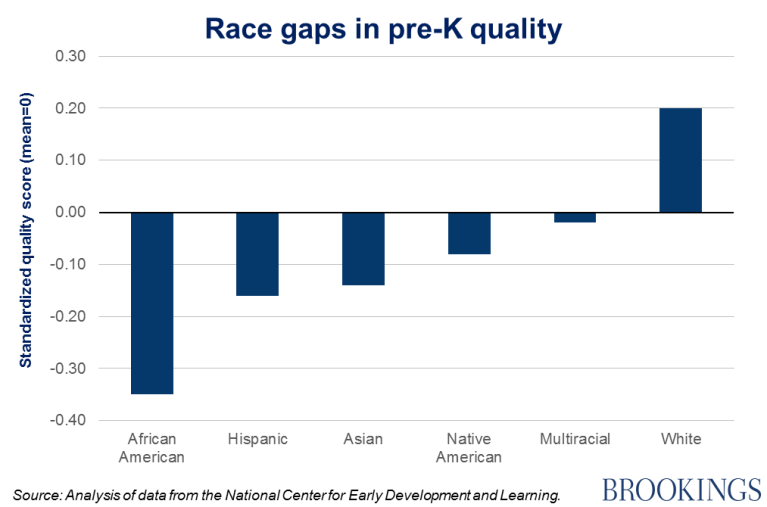Early education lays the foundations for later success. But quality is critical, and quality varies considerably. In particular, there are stark race gaps in the quality of pre-K teaching.
Of course, measuring quality is a complex task, in pre-K at least as much as for K-12 schools or colleges. But robust measures exist, including the Classroom Assessment Scoring System (CLASS) tool, which measures emotional support, classroom organization, and instructional support.
To investigate race gaps in quality, I use data pooled across two large studies from the National Center for Early Development and Learning (NCEDL) at UNC Chapel Hill. Information is available on 721 classrooms and 2,982 students across 11 states offering publicly funded pre-K during 2001 and 2002. (A more detailed paper, that includes an investigation of teacher “self-efficacy” measures, can be found here.)
Race gaps in pre-K quality…
The average black preK-4 student is in a classroom that in terms of quality is .55 standard deviations below the average white student. In fact, all racial groups are in below-average pre-K except whites:

…lead to wider gaps in outcomes
But do these observed race gaps in quality have any implications? It seems so. Children enter pre-K at different levels of learning. The black-white test score gap in the fall is .39 standard deviations, which is relatively small compared to later years (at age 17, the current gap on national exams is .84), and falls to .14 after adjusting for parental education, income, and household composition.
By the following spring, the children will have progressed. But how far? To test how quality affects learning, I predict spring test scores as a function of fall test scores, classroom quality, and student family characteristics. The basic result is that classroom quality and teacher self-efficacy robustly predict learning gains. Including or excluding controls for teacher characteristics—like experience and even student behavioral measures—does not change this result.
If the race gaps in quality (including a measure of teacher self-efficacy, not shown) were eliminated, the black-white difference in test scores in the spring, towards the end of the pre-K year, would drop by 22 percent (adjusted for socioeconomic status). Given that the children are only in pre-K for around 25 hours a week, these are not trivial effects.
Starting from behind the line
Learning gains over the course of the preK-4 year are substantial for children regardless of race. But black children start behind and don’t catch up. This is at least in part because they are more likely to end up in lower-quality pre-K classrooms. Education gaps by race, then, start early and often persist through school, college, and into the labor market. America’s race gaps are stark and stubborn from the cradle to the grave. Closing them will require a concerted effort at each and every stage.







Commentary
Black and Hispanic kids get lower quality pre-K
June 29, 2016